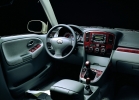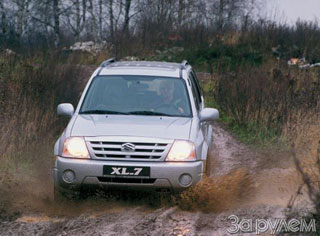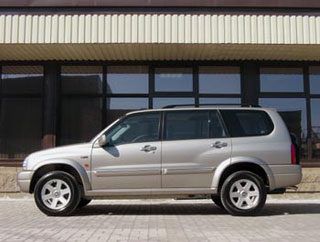Suzuki Grand Vitara XL7 2004 test drive - 2006 SUV
Extra Large
Suzuki is well known in Russia. The bestsellers of production gamut are compact Vitara and Grand Vitara, which, despite the modesty of dimensions, are very serious off -road properties.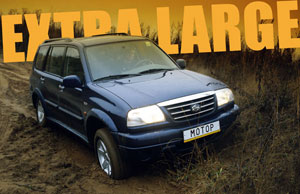 A couple of years ago, the company decided to play larger SUVs in a niche. The Japanese debut of Grand Vitara XL-7 took place in the fall of 2000, and the world premiere was held in early 2001 in Detroit. They didn’t make up sly: they stretched the standard spar frame Grand Vitara, increasing the wheelbase from 2480 to 2800 mm, and the length of the machine from 4195 to 4685 mm. The XL -7 index added to the name is deciphered as follows: XL is Extra Large, and the seven means the number of places.
A couple of years ago, the company decided to play larger SUVs in a niche. The Japanese debut of Grand Vitara XL-7 took place in the fall of 2000, and the world premiere was held in early 2001 in Detroit. They didn’t make up sly: they stretched the standard spar frame Grand Vitara, increasing the wheelbase from 2480 to 2800 mm, and the length of the machine from 4195 to 4685 mm. The XL -7 index added to the name is deciphered as follows: XL is Extra Large, and the seven means the number of places. Outwardly, as expected, Grand Vitara XL-7 is a complete copy of the usual five-door Grand Vitara, if you do not take into account the increased rear side windows. There are no more differences in the cabin than from the outside, the only thing that is immediately striking is the third row of seats, installed almost in the trunk (it was due to the rear over that the car length was increased) and designed for two. An excellent result is such a small car, and by capacity it can compete with other mini -wenes. However, Japanese engineers either forgot or simply did not want to take into account the difference in anthropometric data of the average Japanese and the average European. As a result, if in front and in the second row there are subjects of medium European height, there will be not only a little place for the legs at all - it will not be at all, since the backs of the second row will practically be applied to the third pillows (the seats of the second row have longitudinal adjustment). In addition, in order to get back, you will have to overcome the obstacle in the form of a middle row, which is not as simple as it seems. First you need to move the chair forward, then fold its back, and all operations require the application of decent efforts, and as a result you get a rather narrow passage. It is even more difficult to choose, especially without outside help - all levers are located so that from the back row they are almost inaccessible. In general, this machine should be supplied to the European market with the XL-5+2 index, and if I were the owner, I would remove the back row of seats for unnecessary to use the trunk for its intended purpose.
 Having settled in a driver’s place, you somehow forget about the problems of passengers. The chair is quite convenient and has a wide range of longitudinal adjustment, however, in the back, the adjustment is stepped, and it is difficult to catch the right position. Landing is vertical in a battles, while I went to Grand Vitara XL-7 all day and did not feel fatigue-special thanks to the steering wheel with a well-chosen cross-section and located at the optimal angle (the adjustment range is such that allows you to find the perfect position).
Having settled in a driver’s place, you somehow forget about the problems of passengers. The chair is quite convenient and has a wide range of longitudinal adjustment, however, in the back, the adjustment is stepped, and it is difficult to catch the right position. Landing is vertical in a battles, while I went to Grand Vitara XL-7 all day and did not feel fatigue-special thanks to the steering wheel with a well-chosen cross-section and located at the optimal angle (the adjustment range is such that allows you to find the perfect position). The instrument shield is how modest, so functional, all vital information is read at first sight. The steering wheel switches perform standard functions, the right, however, is also entrusted with the control of the cruise control. The central console looks somewhat archaic: in its upper part there is a long row of buttons responsible for the distribution of air flows, just below - three old -fashioned horizontal engines, knowing the temperature, intensity and a place of air flow. And, of course, the absence of a radio did not improve the interior picture - in its place (2DIN) was a large black plug. Between the seats is an automatic box selector and the transmission operating mode switching lever. There are three of them in total: 2h - the drive to the rear wheels, 4h - a constant four -wheel drive and 4L - a constant all -wheel drive with a lowering gear.
 For a hungry machine, a engine was developed more powerful - 2.7 liters of V6, in which 29 horses more than a 2.5 l of the 144 -horsepower Grand Vitara motor. There are no changes in the chassis ...
For a hungry machine, a engine was developed more powerful - 2.7 liters of V6, in which 29 horses more than a 2.5 l of the 144 -horsepower Grand Vitara motor. There are no changes in the chassis ... The experiments have shown that the most predictably machine behaves in the rear -wheel drive version - the gas and steering pedal and the steering wheel allow you to turn the demolition into a skid and completely control the machine. On all-wheel drive, the speed of maneuvers, of course, increases, but the logical connection of the car-driver suffers, and you feel not so comfortable. The situation is aggravated by a very unusual design of the handbrake: it is transmission, that is, it stops not the wheels of a particular axis, but the entire transmission, so it will no longer be possible to trust the car in a slippery turn with a standard technique.
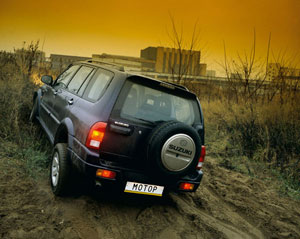 However, the Grand Vitara XL-7 is still not a racing machine, but in terms of reliability, such a scheme will give one hundred points forward standard: the main and spare brake systems are kinematically unleashed, and even if you have brake discs, the machine will still be possible stop.
However, the Grand Vitara XL-7 is still not a racing machine, but in terms of reliability, such a scheme will give one hundred points forward standard: the main and spare brake systems are kinematically unleashed, and even if you have brake discs, the machine will still be possible stop. On off -road, in porridge from dirt and snow, XL -7 proved himself a real fighter - despite the fact that he was shod in road rubber. True, the long base made it difficult to overcome the folds of the terrain. But in a deep rut you feel absolutely calm: in front of the engine is covered with protection, and at the back the lowest place is the beam of the bridge, which is almost impossible to damage. But, as you know, it’s good on off -road, it’s bad on the road. The dependent rear suspension does not allow you to feel confident at speeds above 120 km/h - the screening begins, and on irregularities the stern simply rearranges. It's a shame, because the 173-horsepower six provides Grand Vitara XL-7 very good dynamics.
Text: Alexander Nadens
Source: Motor magazine [No. 4/2002]




